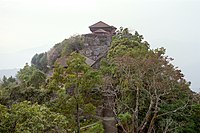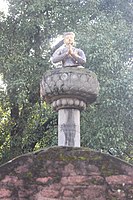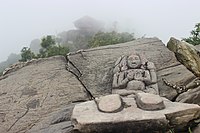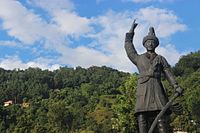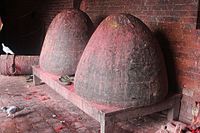Gorkha Kingdom
Kingdom of Gorkha गोरखा राज्य Gorakhā Rājya | |||||||||
|---|---|---|---|---|---|---|---|---|---|
| 1559–1768 CE | |||||||||
Coat of Arms of Shah dynasty
| |||||||||
| Capital | Khas (later Nepali) | ||||||||
| Religion | Hinduism | ||||||||
| Government | Monarchy | ||||||||
| Māhārājādhirāj | |||||||||
• 1559–1570 CE | Dravya Shah (first) | ||||||||
• 1570–1605 CE | Purna Shah | ||||||||
• 1609–1633 CE | Ram Shah | ||||||||
• 1633–1645 CE | Dambar Shah | ||||||||
• 1645–1661 CE | Krishna Shah | ||||||||
• 1661–1673 CE | Rudra Shah | ||||||||
• 1673–1716 CE | Prithvipati Shah | ||||||||
• 1716–1743 CE | Nara Bhupal Shah | ||||||||
• 1743–1768 CE | Prithvi Narayan Shah (last) | ||||||||
| History | |||||||||
• Established | 1559 | ||||||||
• Disestablished | 1768 CE | ||||||||
| |||||||||
| Today part of | Nepal | ||||||||
| History of Nepal |
|---|
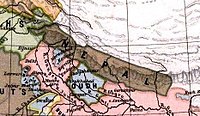 |
|
|
The Gorkha Kingdom (
Origin
According to legend, one of the earliest Shah rulers was Rishi-raj Rana-Ji, of the
Akbar, the Mughal emperor, (1542-1605) wished to marry the daughter of Fatte Sinha Rana-Ji Rava. Akbar was refused because he was not a Hindu but from a different religion (namely Islam). This decision led to the war. Many Rajputs, including Fatte Sinha Rana-ji Rava, were killed. The survivors of the war were led by Udaybam Rana-Ji Rava. They founded a settlement called Udaipur.[3]
Manmath Rana-Ji Rava went to
From Micha, a dynasty of seven rajas commenced in Nuwakot. Kulamandan, the eldest son of Jagdeva, became ruler of
-
The old king's Darbar at Gorkha
-
Mohar of Gorkha king Prithvi Narayan Shah datedSaka Era1685 (1763 CE)
List of kings of Gorkha

The following is a list of the ten kings of the Gorkha principality:[citation needed]
| Name | Lifespan | Reign start | Reign end | Notes | Family | Image |
|---|---|---|---|---|---|---|
Dravya Shah
| died 1570 | 1559 | 1570 | Son of Yasho Brahma Shah | Shah | |
Purna Shah/Purendra Shah
| died 1605 | 1570 | 1605 | Son of Dravya Shah | Shah | |
Chatra Shah
| died 1609 (heirless) | 1605 | 1609 | First son of Purendra/Purna Shah | Shah | |
Ram Shah
| died 1636 | 1609 | 1633 (abdicated) | Second son of Purna/Purendra Shah adopted title of Svasti Sri Giriraj | Shah |  |
Dambar Shah
| died 1645 | 1633 | 1645 | Son of Ram Shah | Shah | |
Krishna Shah
| died 1661 | 1645 | 1661 | Son of Dambar Shah | Shah | |
Rudra Shah
| died 1673 | 1661 | 1673 | Son of Krishna Shah | Shah | |
Prithvipati Shah
| died 1716 | 1673 | 1716 | Son of Rudra Shah | Shah | |
Nara Bhupal Shah
| 1697- 3 April 1743 | 1716 | 1743 | Grandson of Prithvipati Shah and Son of Prince Birbhadra Shah | Shah | |
Prithvi Narayan Shah
| 11 January 1723[citation needed] – 15 January 1775 (aged 52) | 1743 | 25 September 1768 | Son of Nara Bhupal Shah | Shah |  |
Expansion campaign
From 1736, the Gorkhalis engaged in a campaign of expansion begun by King
Among their conquests, the most important and valuable acquisition was the wealthy
The Newars appealed to the British
In 1788, the Gorkhalis turned their attention north and invaded
A later
The Gorkha dominion reached its height at the beginning of the 19th century, extending all along the
Gorkha to Nepal


The Gorkha dominion continued to be known as "Gorkha Rajya" (lit. 'Gorkha Kingdom') until the beginning of the 20th century. Historically, the name 'Nepal' referred mainly to Kathmandu valley, the homeland of the Newars. Since the 1930s, the state began using it to refer to the entire country and 'Nepal Khaldo' (Nepal Valley) became 'Kathmandu Valley'.[16][17] The name Gorkha Sarkar (meaning Gorkha government) was also changed to Nepal government.
Similarly, the Gorkhali language was renamed as Nepali in 1933.[18] The term Gorkhali in the former national anthem entitled "Shreeman Gambhir" was changed to Nepali in 1951.[19] The government newspaper, launched in 1901, is still known as Gorkhapatra (meaning Gorkha gazette).
The Shah dynasty ruled Nepal until 2008 when it became a republic following a people's movement.[20] Today, Gorkha District, roughly corresponding to the old kingdom, is one of the 77 administrative districts of Nepal.
Gurkhas

Not to be confused with the inhabitants of the old Gorkha Kingdom only, the
During
Gallery
-
Metal Window
-
Stone history
-
Gorkha Durbar
-
King Prithavi Pal
-
Image of Goddess & Gorkha Palace
-
Gorkha Tallo Durbar
-
Shree Panch Bada Maharajadhiraj Prithavi Narayan Shah Dev
-
Nepali Cannon
-
Nagada
See also
References
- ^ Hamilton, Francis Buchanan (1819). An Account of the Kingdom Of Nepal and of the Territories Annexed to This Dominion by the House of Gorkha. Edinburgh: Longman. Archived from the original on 13 November 2012. Retrieved 12 January 2013. Page 237.
- ^ Kirkpatrick, Colonel (1811). An Account of the Kingdom of Nepaul. London: William Miller. Retrieved 12 January 2013. Page 123.
- ^ a b c d e Daniel Wright, History of Nepāl, Cambridge University Press, 1877, Nepal. Chapter X, page 273
- ^ "Bringing Aid To Gorkha's Poor | Features | ECS Nepal - The Nepali Way". ecs.com.np. Archived from the original on 2022-01-16. Retrieved 2017-04-23.
- ^ Hamilton, Francis Buchanan (1819). An Account of the Kingdom Of Nepal and of the Territories Annexed to This Dominion by the House of Gorkha. Edinburgh: Longman. Archived from the original on 13 November 2012. Retrieved 6 January 2013. Page 7.
- ISBN 9788120615779. Pages 30-31.
- ISBN 9780415336475.
- ^ Hamilton, Francis Buchanan (1819). An Account of the Kingdom Of Nepal and of the Territories Annexed to This Dominion by the House of Gorkha. Edinburgh: Longman. Archived from the original on 13 November 2012. Retrieved 15 January 2013. Page 7.
- ISBN 9780415336475.
- ^ a b c "Nepalese Army | नेपाली सेना". Archived from the original on 2016-12-20. Retrieved 2017-02-05.
- ^ Kirkpatrick, Colonel (1811). An Account of the Kingdom of Nepaul. London: William Miller. Retrieved 11 February 2013.
- ^ Boulnois, L. "Chinese Maps and Prints on the Tibet-Gorkha War of 1788-92" (PDF). Kailash. p. 86. Archived (PDF) from the original on 24 February 2021. Retrieved 21 January 2013.
- ^ "The Enclosing of Nepal". U.S. Library of Congress. Archived from the original on 23 June 2011. Retrieved 21 January 2013.
- ISBN 978-0-19-562723-7. Retrieved 6 February 2013.
- ASIN B001OQE7EY.
- ^ Planet, Lonely. "History of Nepal - Lonely Planet Travel Information". www.lonelyplanet.com. Archived from the original on 2017-09-22. Retrieved 2016-05-08.
- ISBN 9781742203614.
- ISBN 81-208-0963-7. Page 3.
- ^ "The kings song". Himal Southasian. June 2003. Archived from the original on 25 October 2012. Retrieved 3 April 2012.
- ^ "Nepal's Gorkha kingdom falls". The Times of India. 2 June 2008. Archived from the original on 11 April 2013. Retrieved 11 February 2013.
- ISBN 978-0-7553-1415-7.



